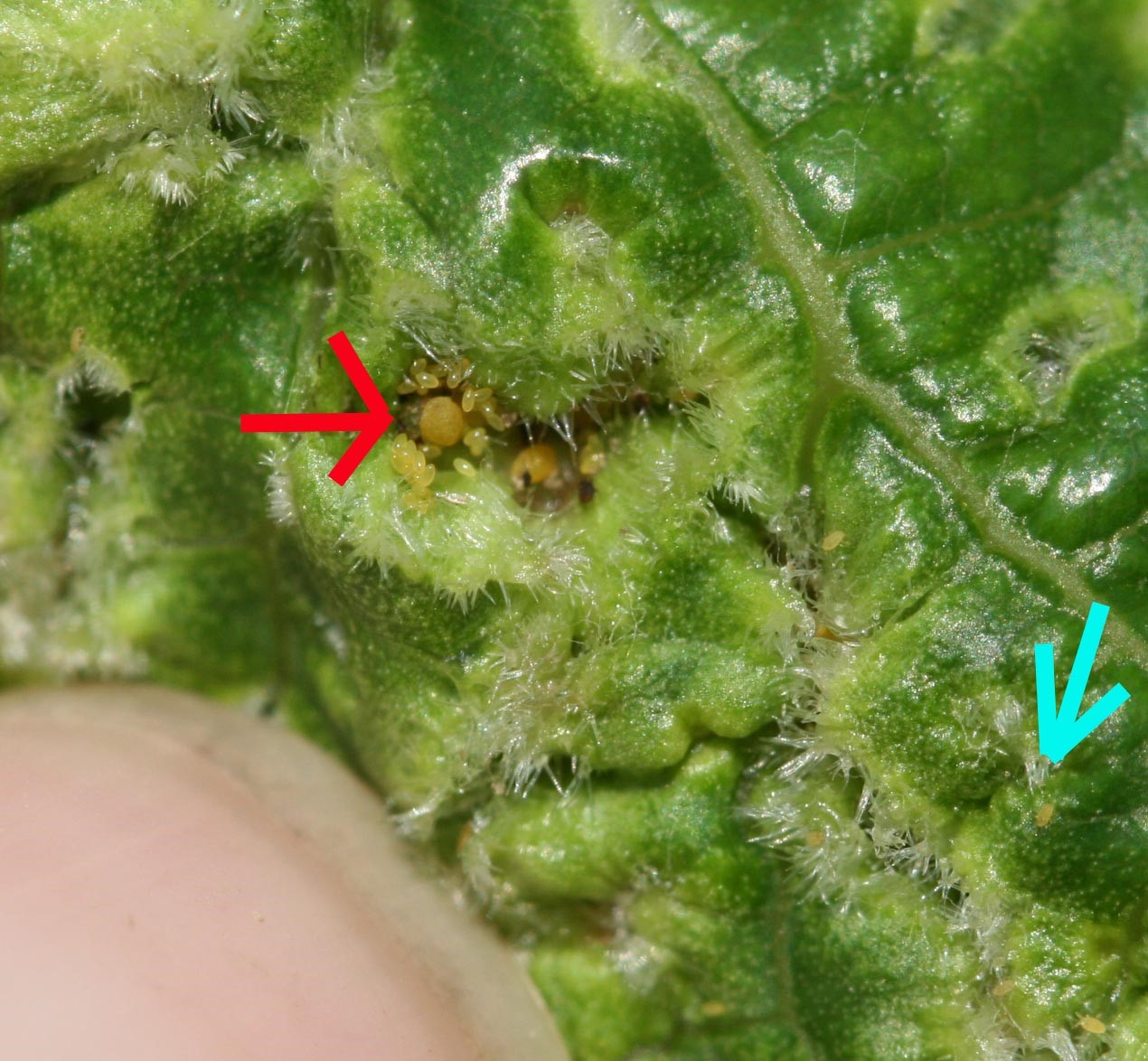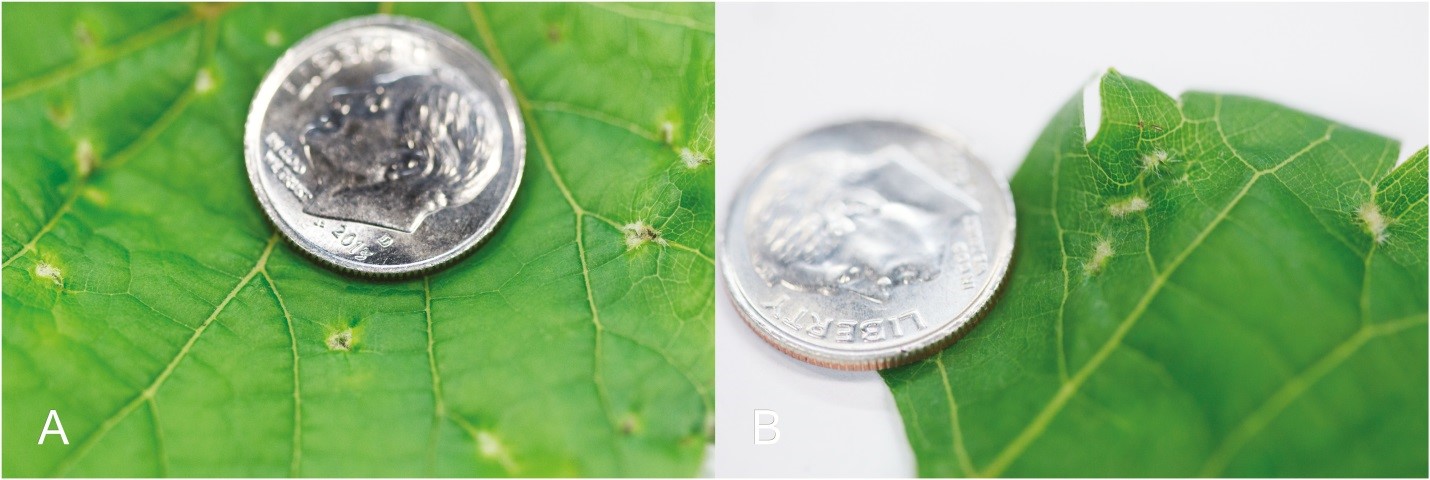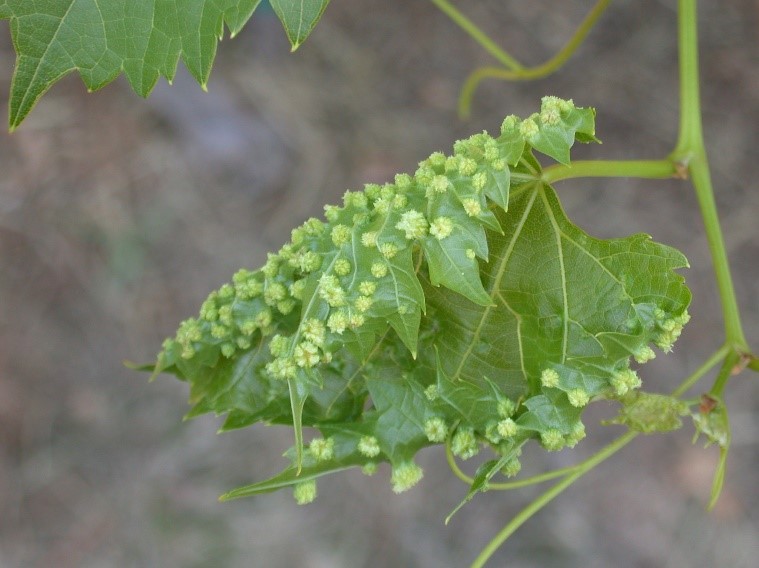Bill Hutchison1, Eric Burkness1, Lu Yin2 & Matt Clark3
1Dept. of Entomology, Extension IPM Program, 2Graduate Student, Dept. of Horticultural Science, & 3Dept. of Horticultural Science & UMN Extension, University of Minnesota
The foliar form of Grape Phylloxera (GP) is quite common throughout Minnesota and most eastern grape growing regions of the U.S. Although we have experienced a late spring so far this year, the first grape leaves for most hybrids have started to appear; this is a good time to begin monitoring for the “yellow crawler” stage of GP, as the crawlers hatch from their “mother” galls (including a female with several eggs, Fig. 1).
Grape Phylloxera Life Cycle
In brief, the GP life cycle is quite complex, with galls formed on both root and foliar portions of the vine. However, given the genetic background of the cold-hardy grape hybrids in the Midwest region, the primary potential for damage is the presence of foliar galls formed by GP. Much of this information is taken from a recent publication by one of our graduate students in Horticultural Science, Lu Yin (Yin et al. 2019; see full citation below).
Figure 1: Mature grape phylloxera female and eggs (indicated by red arrow) and crawler (blue arrow) on a young grape leaf (Hannah Burrack, NC State).
Following the hatch of overwintered eggs (on trunk of vine), typically in early May (though later this year), the first-generation nymphs, or “crawlers” move to the grape shoots to feed on 1st to 3rd expanding terminal leaves. The leaf forms a gall around each crawler; at this time the crawlers will form less than 5 galls/leaf. During May-June, each crawler matures within the gall (Fig. 1) and will produce 100-300 yellow, oblong eggs. The subsequent emergence of young 2nd generation crawlers (Fig. 1) will begin, and crawlers will move out from the “mother gall”, to establish new galls on new leaves during the summer months (Fig. 2 and 3).
Figure 2: Fig. 2. Early pin-sized galls (open), and mature foliar galls (closed), Grape Phylloxera, MN (Lu Yin, Univ. of Minnesota).
Figure 3: Mature foliar galls formed by Grape Phylloxera crawlers (E. Burkness, Univ. of Minnesota).
Scouting and Management
The crawlers that hatch from the mother eggs, are the most critical generation for timing a 1st insecticide application, early summer. These crawlers will walk up the plants to 5-6th open leaves, and generate 40-50 galls per leaf, common on susceptible varieties. Three or more generations can occur in MN depending on the year, with additional galls being formed throughout summer.
For timing, growers can use a degree-day (DD) or “heat unit” model to track the initial infestation rates of crawlers. Degree-days for GP are calculated from the bio-fix date (time at which 1st leaves unfurl) by the following: DD = Average daily temperature – 43F, and accumulate DDs each day. The 2nd generation crawler emergence period occurs at 500-800 DDs; in MN we recommend to start scouting at 450 DDs, and twice weekly when possible.
Regarding insecticidal control, the two most common options used in MN have been Danitol (pyrethroid) and Movento (systemic). To minimize the risk of resistance, these can be alternated (via different modes of action). In most years, only one spray for GP is necessary, or a maximum of 2 sprays.
With Movento, on recent on-farm trials, we have found that one application is often sufficient. After the first spray, check again for any additional gall formation instead of assuming an automatic 2nd spray is needed. As with other crops, sprays should ideally be applied during the evening hours to minimize the risk of direct contact, and mortality to bees and pollinators. Prior to any insecticide use, the label should be reviewed carefully to follow all application safety and use requirements. For more information, review the 2019 Fruit Pest Management Guide (cited below). Finally, in recent years, for some MN vineyards, we have noticed that once GP has been controlled (1 or 2 sprays), it may take up to 2 additional years for the pest population to re-establish, at least at high levels. Bottom-line: to monitor vineyards each spring/summer to verify low or high infestations via the presence of early galls.
More Information
For more information on insecticide options for managing GP, see the 2019-2020 Midwest Fruit Pest Management Guide, at: https://ag.purdue.edu/hla/Hort/Documents/ID-465.pdf
For more information on the history and biology of grape Phylloxera in the U.S., click here for the open access article by Lu Yin et al. (2019), https://academic.oup.com/jipm/article/10/1/16/5490144
For additional Fruit Insect IPM updates, see: www.fruitedge.umn.edu


